Lightweight portable bean tables could be found in the interiors of many noble houses. They appeared in the 18th century, when the Rococo style dominated in the Russian Empire, and remained popular throughout the first half of the 19th century.
Rococo interiors were very elegant. The walls were decorated with wooden panels. The rooms had patterned parquet flooring. Pastel colors were dominant: pink, blue, light green combined with gold and silver. Furniture with curved legs was lavishly decorated with carvings and gilded.
The bean table with a pull-out drawer was acquired by the Museum Estate from an antique shop in Moscow. The surface of the tabletop is decorated in the marquetry technique and features a geometric diamond-shaped ornament with a four-petalled flower in the center. The legs and the frame of the table are made up of a curvilinear underframe, which repeats the line of the tabletop, with a small drawer inside. The underframe is the upper connecting bar between the legs of the table. It rests on four square legs which taper towards the bottom.
The art of wood marquetry dates back to ancient times. The term comes from the French ‘marquer’ which means ‘to mark’, ‘to draw’. The decorative pattern in this technique is made of shaped pieces of veneer sheets of different colors and textures of woods with a thickness of no more than one millimeter. The mosaic elements are cut into the background veneer sheet according to the sketch previously made on paper, fixed with adhesive paper (gummed paper) and then glued together with the background under the press onto the surface of the item. Elements of marquetry are common in the decoration of exquisite furniture of the late Middle Ages, the Renaissance, as well as the Classicism and Empire furniture.
Wood mosaics are also used to create separate artistic compositions and panels. The process of making marquetry paintings is considered one of the most time-consuming in all of artforms, as craftsmen spend a lot of time selecting the necessary elements for the mosaic. Sometimes it can take more than one week to create a portrait or a landscape.
Rococo interiors were very elegant. The walls were decorated with wooden panels. The rooms had patterned parquet flooring. Pastel colors were dominant: pink, blue, light green combined with gold and silver. Furniture with curved legs was lavishly decorated with carvings and gilded.
The bean table with a pull-out drawer was acquired by the Museum Estate from an antique shop in Moscow. The surface of the tabletop is decorated in the marquetry technique and features a geometric diamond-shaped ornament with a four-petalled flower in the center. The legs and the frame of the table are made up of a curvilinear underframe, which repeats the line of the tabletop, with a small drawer inside. The underframe is the upper connecting bar between the legs of the table. It rests on four square legs which taper towards the bottom.
The art of wood marquetry dates back to ancient times. The term comes from the French ‘marquer’ which means ‘to mark’, ‘to draw’. The decorative pattern in this technique is made of shaped pieces of veneer sheets of different colors and textures of woods with a thickness of no more than one millimeter. The mosaic elements are cut into the background veneer sheet according to the sketch previously made on paper, fixed with adhesive paper (gummed paper) and then glued together with the background under the press onto the surface of the item. Elements of marquetry are common in the decoration of exquisite furniture of the late Middle Ages, the Renaissance, as well as the Classicism and Empire furniture.
Wood mosaics are also used to create separate artistic compositions and panels. The process of making marquetry paintings is considered one of the most time-consuming in all of artforms, as craftsmen spend a lot of time selecting the necessary elements for the mosaic. Sometimes it can take more than one week to create a portrait or a landscape.

